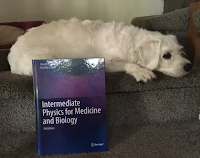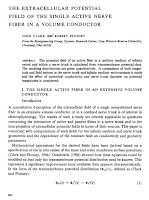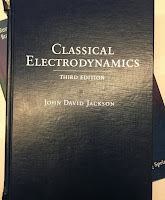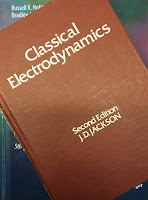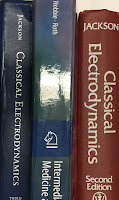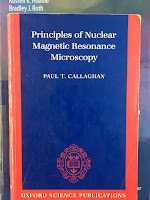 |
| Thomas Tenforde (1940-2019). Photo used with permission of the Health Physics Society. |
When I was looking for employment in the late 1980s just after getting my PhD, I had a fellowship opportunity at the Pacific Northwest National Laboratory in Richland, Washington, where Tom Tenforde worked. At that time a debate raged about the health risks of 60-Hz power-line fields, and I recall having much respect for Tenforde’s research on this topic; his work seemed more rigorous and physics-based than many other studies. I ended up taking a position at the National Institutes of Health, but I seriously considered working for Tenforde.
When Russ Hobbie and I discuss power-line electric and magnetic fields in Intermediate Physics for Medicine and Biology, we cite a review by Tenforde.
9.10.2 Power Frequency (50-60 Hz) Fields
9.10.2.1 Fields in Homes are Weak
Much weaker fields in homes are produced by power lines, house wiring, and electrical appliances. Barnes (1995) found average electric fields in air next to the body of about 7 V m−1, with peak values of 200 V m−1. (We will find that since the body is a conductor, the fields within the body are much less.) Average residential magnetic fields are about 0.1 μT, with peaks up to four times as large. Within the body they are about the same. Tenforde (1995) reviews both power-line and radio-frequency field intensities.
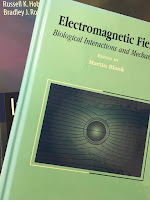 |
| Electromagnetic Fields: Biological Interactions and Mechanisms, edited by Martin Blank. |
Tenforde TS (1995) Spectrum and intensity of environmental electromagnetic fields from natural and man-made sources. In: Blank M (ed.) Electromagnetic Fields: Biological Interactions and Mechanisms. American Chemical Society, Washington, DC, pp 13–35.An obituary for Tenforde published online by the Health Physics Society begins
Thomas S. Tenforde died on 6 September 2019 in Berkeley, California, at the age of 78. He was born in Middletown, Ohio, on 15 December 1940. He received his BA degree from Harvard University with a major in physics. He earned a PhD in biophysics at the University of California at Berkeley. He was a senior scientist at the Lawrence Berkeley National Laboratory from 1969 to 1988. He moved to Richland, Washington, where he was a fellow at Battelle's Pacific Northwest National Laboratory from 1988 to 2002. His special areas of research included health effects of nonionizing radiation and the role of radionuclides for medical applications. He received the d’Arsonval Medal from the Bioelectromagnetics Society in 2001. He also received awards from the US Department of Energy in 2000 and the Federal Laboratory Consortium in 2001 for leading the development of 90Y as a therapeutic medical isotope that is used worldwide for the treatment of cancer and other medical disorders...
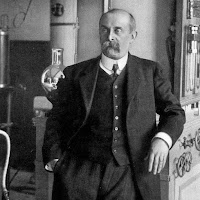 |
| Jacques-Arsène d’Arsonval (1851-1940). Photo from Wikipedia. |
Thomas S. Tenforde, senior chief scientist in the environmental technology division, Pacific Northwest National Laboratory, Richland, Wash., will receive the eighth d’Arsonval Award, presented by the Bioelectromagnetics Society to recognize “extraordinary accomplishment within the discipline of bioelectromagnetics.” This award recognizes Tenforde’s extensive research on dosimetry and biophysical interaction of static and low-frequency electric and magnetic fields with living systems….
Tenforde’s strong interest in bioelectromagnetics began with the use of static electric fields for single-cell micro-electrophoresis during his doctoral thesis work. In the 1970s and 1980s at Lawrence Berkeley National Laboratory he conducted a broad range of biological studies on static and ELF [extremely low frequency] magnetic fields. Tom and his colleagues at the Donner Laboratory at the University of California developed what soon became the foremost program investigating the biological effects of strong static magnetic fields. These studies looked at the cardiovascular system, the nervous system, thermoregulation, circadian rhythmicity, lipid bilayer membrane permeability, and animal behavior.
This work initially began because of concerns about human exposure to strong magnetic fields near thermonuclear fusion reactors, magneto-hydrodynamic power systems, and high-energy physics facilities such as cyclotrons and bubble chambers. Tom and his colleagues played a key role in the evaluation of potential risks to patients and workers from MRI facilities…Tenforde provides yet another example of a scientist who made the transition from physics to biology. His career indicates how working at this interface can lead to new insights and great accomplishments. His interest in how magnetic fields affect animals overlaps with my work on the magnetic field of a nerve axon, magnetic stimulation and magnetoacoustic imaging. I think he would have enjoyed Chapter 8 of Intermediate Physics for Medicine and Biology, about biomagnetism.
As manager of PNNL’s Hanford Radioisotopes Program, Tenforde supervised work which produced the medical isotope yttrium-90, which is now being used worldwide to treat cancer…
I will let Tenforde have the last word. In an article based on his speech accepting the d’Arsonval Medal (Bioelectromagnetics, Volume 24, Pages 3-11, 2003), he wrote
A recurring theme of my work during the past 25 years has been the beneficial uses of magnetism in advancing our scientific knowledge of living systems, and hence I have chosen the title, “The Wonders of Magnetism.”






